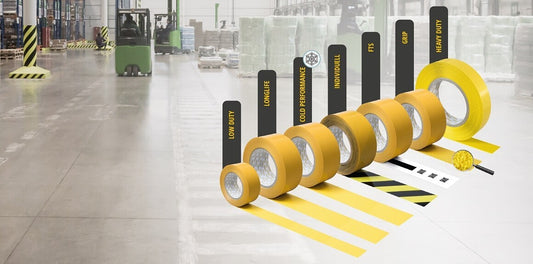Typically those working in logistics or manufacturing organisations may be aware of the term 'Lean Management' but do you really understand the benefits this method could have to your workplace? And what about the aspect of Just-In-Time (JIT) manufacturing?
As a manufacturer of Lean Management products, read on to see how JIT manufacturing and production can lead to Lean operations, which can save lost time and money on inventory.
What is Just-in-Time Manufacturing?
Just-In-Time Manufacturing is a process where, rather than producing goods or products and adding them to stock, you instead focus production on items which have been ordered for when your customers need them. This helps to meet demand and removes surplus items; saving on time and storage space. And, this particular method is often used in the food industry, where an item of food is ordered and then cooked, rather than cooked ahead of time, hoping that someone orders it after the fact.
This philosophy was introduced by Taiichi Ohno, an industrial engineer and manufacturer whose work revolutionised Toyota and its production methods.
The Advantages of JIT Manufacturing
JIT manufacturing has many advantages to the production of goods. Most notably, the advantages of JIT are:
- Minimising product defects
- Removing the need for costly inventory systems
- Reducing the risk of storing obsolete parts
- Reducing the amount tied up in stock
- Reduction of transport costs
- Prevention of overproduction
These advantages are key to any business that wants to reduce its overheads. Often, the overheads that a business incurs are the first to be under scrutiny when you are looking at implementing a Lean Manufacturing philosophy. The areas listed above are often a large part of overheads for manufacturing companies. Therefore, the advantages of JIT manufacturing are a great way to reduce these costs. Talk to us about reducing your overheads with products that support JIT manufacturing and Lean Management practices.
The Disadvantages of JIT Manufacturing
Whilst the benefits of JIT manufacturing are plentiful, there are some disadvantages that make it an unsuitable approach for some organisations such as:
- You build up a dependence on your own suppliers - in a way, you push back your own inventory space and effort to your own suppliers. Should this supply end for whatever reason, you no longer have anything to produce.
- You no longer hold stock, should you need it - losing inventory can save money in the long run. However, not having that stock to fall back on should something go wrong can be stressful.
- Potential to be over-dependent on data - production is now dependent on sales data, which may mean that you need to continuously oversee production methods and keep an eye on input and output more often.
These issues with JIT manufacturing are widely known. As a middle ground, Just-In-Case manufacturing was introduced.
Just-In-Time VS Just-In-Case Manufacturing
Just-In-Case Manufacturing is similar to JIT, however your company relies on a small amount of stock just in case you run out. This method has its advantages over Just in Time manufacturing as you no longer run the risk of running out of one or two essential items needed for production. Though you are still relying on expensive storage space, so what’s the benefit?
he main benefit of Just-In-Case Manufacturing is that you have just created a buffer which can offer flexibility should suppliers not deliver. Your business is now less reactive to supply chain issues issues, but you have once again created an inventory system, but with fewer items.
You will still incur the staffing costs of inventory management and experience the risk of having your stock become obsolete with Just-In-Case manufacturing, but it is a good middle ground when getting started with Just in Time manufacturing.
If you are keen to learn more about stock levels in JIT and Just-In-Case manufacturing, read: What is Buffer Stock & is it Good For a Lean Business?
Where Would Just-In-Time Manufacturing Be Useful?
Just-In-Time manufacturing can be useful in many industries. Most notably, it can be implemented across the manufacture of rarely required, specialist products. However, once the philosophy is effectively introduced, it can lead small, medium or large companies to become more efficient, in whatever products they create.
It can be most useful for businesses that specialise in:
- Publishing
- Retail
- The food industry
- Automotive manufacturing
- Specialist manufacturing
Whilst these industries have historically shown improvements with JIT manufacturing, any industry that produces its own products could benefit from this Lean production method.
If you’d like to learn more about lean manufacturing methods, read: What is Lean Management & 5 Simple Steps To Implement
How To Implement Just-In-Time Manufacturing
Just-In-Time manufacturing should be implemented over a sustained period of time. This allows your staff ample time to adjust to new procedures, methods and techniques. To do this, the following important steps should be followed to allow your business to successfully produce goods according to Just-In-Time methods.
Review Your Sales Data
A thorough review of your sales data should be the first step in your implementation of JIT. Reviewing trends in sales data and understanding your customers' requirements should allow you to understand those products which need to be produced and when.
Review Your Suppliers
Once you have a better understanding of your customer’s needs, you then need to address your own needs similarly. Speaking with your suppliers and arranging smaller, but more frequent deliveries of necessary supplies will help you reduce stock holding, and the costs associated with it.
Develop An Idea of Demand
Now that you are familiar with the data that your business produces under normal situations, you need to develop a better understanding of demand. Your new production method is replacing items that have been used for production, so ordering replacements effectively and on time is the next crucial step.
Adapt to New Methods
Now that you are holding less incoming and outgoing stock, let your inventory systems and customers adjust to this new change.
In logistical industries, this may mean the addition of more turn-around time for shipping items. For manufacturing, your customers need to understand that their products are being made to specification, which may incur more time.
Continually review and tweak your production methods as needed, as this contributes to continuous improvement within your organisation.
Implementing JIT Manufacturing with OrgatexUK
The addition of the JIT philosophy is a large overhaul of your inventory and production management. To assist your new system, Orgatex has designed tools to help your workforce not only understand JIT manufacturing but also thrive under its implementation.
Kanban Boards are one way in which your new push-pull inventory system can thrive. The visual cues that Kanban Boards use enables your staff to see how supply and demand play out in your workplace in real-time.
Understanding your company's inner workings, material supply, and production methods can better your understanding of how to implement JIT manufacturing. For more information from OrgatexUK, the leading supplier of JIT tools and techniques, please don’t hesitate to contact us today for a consultation.












